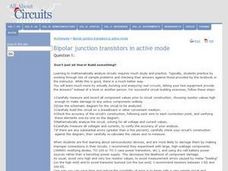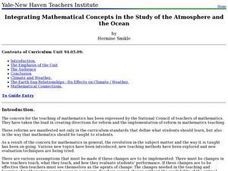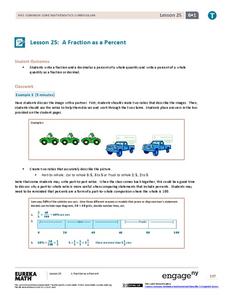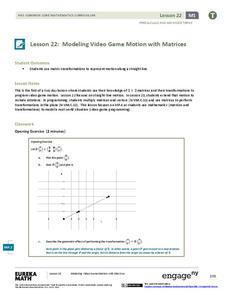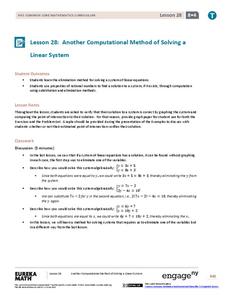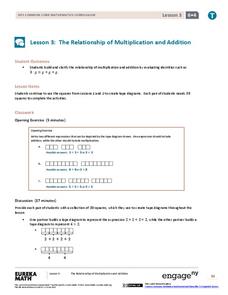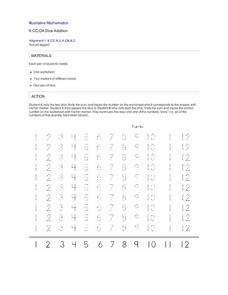Curated OER
New York State Testing Programs Mathematics Test
In this math worksheet, students review algebraic and geometric concepts as they review for the final exam of 6th grade. There are 35 questions.
Curated OER
Exploring Geometry in the Real World
Students find real-world examples of a variety of geometric shapes. They conduct research, record observations, and write descriptions. They create a classroom cityscape and highlight the information they gathered. They present an oral...
Curated OER
Bipolar Junction Transistors in Active Mode
In this physics worksheet, students analyze different schematic diagrams and answer the questions that follow. They solve and write short answers to 23 questions on circuits.
Curated OER
Power Laws
In this power laws worksheet, students solve and complete 6 different types of problems. First, they express each using powers and write in index form with a given base. Then, students calculate each problem and write in simplest terms.
Curated OER
Mathematical Properties
Seventh graders discuss the associative property of math. They are to find examples of the property and others. They also write in their journals about what they learned.
Curated OER
Mathematical Wackie Wordies
In this word worksheet, 9th graders examine pictures and write a mathematical phrase to describe the picture. This one-page worksheet contains 25 problems. Answers are provided.
Curated OER
Integrating Mathematics Into Literature
Students discuss tables, multiples, fractions, ratios, and probability while participating in daily activities in this cross-curricular Math lesson using examples from Literature. State standards in Mathematics are addressed over the...
Curated OER
Integrating Mathematical Concepts in the Study of the Atmosphere and the Ocean
Students utilize problem solving strategies that emphasis writing in mathematics, and strategies that have students make decisions and draw conclusions. They connect math to weather and climate topics.
Curated OER
Investigation - Who is Right?
Third graders investigate two mathematic scenarios and determine which is correct. They compare adding columns and places (such as the tens place, hundreds place, and so on) and familiarize themselves with how to add larger numbers.
EngageNY
End-of-Module Assessment Task: Grade 8 Module 1
It's all in the numbers. Determine your pupils' level of understanding of scientific notation using this assessment task. The final lesson in the series assesses scholars on the application of scientific notation in real-life...
EngageNY
Solving Area Problems Using Scale Drawings
Calculate the areas of scale drawings until a more efficient method emerges. Pupils find the relationship between the scale factor of a scale drawing and the scale of the areas. They determine the scale of the areas is the square of the...
EngageNY
A Fraction as a Percent
It is all about being equivalent. Class members convert between fractions, decimals, and percents. By using visual models, scholars verify their conversions in the 25th portion of a 29-part series.
Curated OER
Math On the Job
Investigate different types of math required for specific jobs. In this math in occupations lesson, use the Internet to research what type of math one might need to know in order to be successful in different jobs. Complete a...
EngageNY
Mid-Module Assessment Task: Grade 6 Math Module 2
Make sure scholars know all about fractions and decimals — not just a fraction of the information. The 12th installment of a 21-part series is a mid-module assessment. Learners solve problems in the context of a birthday party and a...
Curated OER
The Battle for Ultimate Power
Students gain an understanding of how the powers of 10 and scientific notation can be used to represent the scale of things in the universe. They relate the number of stars in the universe to the number of grains of sand on Earth's beaches.
EngageNY
Negative Exponents and the Laws of Exponents
Apply the properties of exponents to expressions with negative exponents. The fifth lesson in the series explains the meaning of negative exponents through an exploration of the properties taught in the previous lessons of the...
EngageNY
Modeling Video Game Motion with Matrices 1
Video game characters move straight with matrices. The first day of a two-day lesson plan introduces the class to linear transformations that produce straight line motion. The 23rd part in a 32-part series has pupils determine the...
EngageNY
Vectors and the Equation of a Line
Represent linear equations in both two and three dimensions using parametric equations. Learners write parametric equations for linear equations in both two and three variables. They graph and convert the parametric equations to...
EngageNY
Another Computational Model of Solving a Linear System
The process of elimination really works! Use elimination when substitution isn't doing the job. The 29th segment in a series of 33 introduces the elimination method to solving linear systems. Pupils work several exercises to grasp the...
EngageNY
Even and Odd Numbers
Even or not, here I come. Groups investigate the parity of products and sums of whole numbers in the 17th lesson plan in a series of 21. Using dots to represent numbers, they develop a pattern for the products of two even numbers; two...
EngageNY
The Relationship of Multiplication and Addition
You know 4 + 4 + 4 = 3(4), but what about x + x + x? Pairs work together to develop equivalent expressions relating multiplication and addition in the third lesson of a 36-part series. They extend their knowledge of multiplication as...
Curated OER
Visualizing Skip Counting by 2
Drawing pictures to solve math problems is not only a good problem solving strategy, it's also mathematical modeling. First graders read six basic word problems that have them skip count by twos to find the answer. They draw pictures in...
Curated OER
Dice Addition
Using the provided tracing number worksheet, a pair of kindergartners will practice their adding skills. Player A will roll two die, add the sum, and then trace the sum on the worksheet. Player B will take a turn and do the same. The...
EngageNY
Designing Your Own Game
Your classes become video game designers for a day! They utilize their matrices, vectors, and transformation skills to create and design their own game images. The complex task requires learners to apply multiple concepts to create their...


